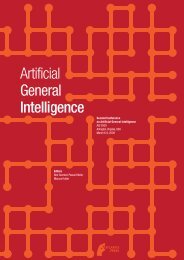Advances in Intelligent Systems Research - of Marcus Hutter
Advances in Intelligent Systems Research - of Marcus Hutter
Advances in Intelligent Systems Research - of Marcus Hutter
You also want an ePaper? Increase the reach of your titles
YUMPU automatically turns print PDFs into web optimized ePapers that Google loves.
Central would be a two-way <strong>in</strong>teraction between<br />
perception and cognition. This <strong>in</strong>teraction must be coupled<br />
with an <strong>in</strong>cremental learn<strong>in</strong>g system, capable <strong>of</strong> acquir<strong>in</strong>g a<br />
vast and coherent structure <strong>of</strong> nodes and l<strong>in</strong>ks. But also,<br />
paradoxically perhaps, the architecture should exhibit strong<br />
constra<strong>in</strong>ts, such as limited process<strong>in</strong>g time or short-term<br />
memory capacities. These limits lie beh<strong>in</strong>d some <strong>of</strong> the key<br />
empirical challenges to computational theories <strong>of</strong><br />
psychological behaviour.<br />
Acknowledgements<br />
This research was supported by the Economics and Social<br />
<strong>Research</strong> Council under grant number RES-000-23-1601.<br />
References<br />
Anderson, J. R., and Lebière, C. (Eds.). (1998). The atomic<br />
components <strong>of</strong> thought. Mahwah, NJ: Erlbaum.<br />
Chase, W. G., and Simon, H. A. (1973). Perception <strong>in</strong><br />
chess. Cognitive Psychology, 4, 55-81.<br />
De Groot, A. D., and Gobet, F. (1996). Perception and<br />
memory <strong>in</strong> chess: Heuristics <strong>of</strong> the pr<strong>of</strong>essional eye. Assen:<br />
Van Gorcum.<br />
Dreyfus, H., and Dreyfus, S. (1986). M<strong>in</strong>d over mach<strong>in</strong>e.<br />
New York: Free Press.<br />
Feigenbaum, E. A., and Simon, H. A. (1984). EPAM-like<br />
models <strong>of</strong> recognition and learn<strong>in</strong>g. Cognitive Science, 8,<br />
305-336.<br />
Freudenthal, D., P<strong>in</strong>e, J. M., Aguado-Orea, J. & Gobet, F.<br />
(2007). Modell<strong>in</strong>g the developmental pattern<strong>in</strong>g <strong>of</strong> f<strong>in</strong>iteness<br />
mark<strong>in</strong>g <strong>in</strong> English, Dutch, German and Spanish us<strong>in</strong>g<br />
MOSAIC. Cognitive Science, 31, 311-341.<br />
Freudenthal, D., P<strong>in</strong>e, J. M., & Gobet, F. (2009).<br />
Simulat<strong>in</strong>g the referential properties <strong>of</strong> Dutch, German and<br />
English Root Inf<strong>in</strong>itives <strong>in</strong> MOSAIC. Language Learn<strong>in</strong>g<br />
and Development, 5, 1-29.<br />
Gobet, F. (1997). A pattern-recognition theory <strong>of</strong> search <strong>in</strong><br />
expert problem solv<strong>in</strong>g. Th<strong>in</strong>k<strong>in</strong>g and Reason<strong>in</strong>g, 3, 291-313.<br />
Gobet, F. (2009). Us<strong>in</strong>g a cognitive architecture for<br />
address<strong>in</strong>g the question <strong>of</strong> cognitive universals <strong>in</strong> crosscultural<br />
psychology: The example <strong>of</strong> awalé. Journal <strong>of</strong><br />
Cross-Cultural Psychology, 40, 627-648.<br />
Gobet, F., and Jansen, P. (1994). Towards a chess program<br />
based on a model <strong>of</strong> human memory. In H. J. van den Herik,<br />
I. S. Herschberg and J. E. Uiterwijk (Eds.), <strong>Advances</strong> <strong>in</strong><br />
Computer Chess 7 (pp. 35-60). Maastricht: University <strong>of</strong><br />
Limburg Press.<br />
Gobet, F., Lane, P. C. R., Croker, S., Cheng, P. C.-H.,<br />
Jones, G., Oliver, I., and P<strong>in</strong>e, J. M. (2001). Chunk<strong>in</strong>g<br />
mechanisms <strong>in</strong> human learn<strong>in</strong>g. Trends <strong>in</strong> Cognitive<br />
Sciences, 5, 236-243.<br />
Gobet, F., Richman, H., Staszewski, J., and Simon, H. A.<br />
(1997). Goals, representations, and strategies <strong>in</strong> a concept<br />
atta<strong>in</strong>ment task: The EPAM model. The Psychology <strong>of</strong><br />
Learn<strong>in</strong>g and Motivation, 37, 265-290.<br />
Gobet, F., and Simon, H. A. (1996). Recall <strong>of</strong> rapidly<br />
presented random chess positions is a function <strong>of</strong> skill.<br />
Psychonomic Bullet<strong>in</strong> and Review, 3, 159-163.<br />
Gobet, F., and Simon, H. A. (2000). Five seconds or sixty?<br />
Presentation time <strong>in</strong> expert memory. Cognitive Science, 24,<br />
651-682.<br />
Gobet, F., and Waters, A. J. (2003). The role <strong>of</strong> constra<strong>in</strong>ts<br />
<strong>in</strong> expert memory. Journal <strong>of</strong> Experimental Psychology:<br />
Learn<strong>in</strong>g, Memory and Cognition, 29, 1082-1094.<br />
Grey Walter, W. The liv<strong>in</strong>g bra<strong>in</strong> (1953). London, UK:<br />
Pengu<strong>in</strong>.<br />
Han, J.W., Lane, P.C.R., Davey, N. and Sun Y. (2009).<br />
Attention mechanisms and component-based face detection.<br />
Proceed<strong>in</strong>gs <strong>of</strong> the International Conference on Methods and<br />
Models <strong>in</strong> Computer Science (IEEE Computer Society).<br />
Jones, G., Gobet, F., & P<strong>in</strong>e, J. M. (2007). L<strong>in</strong>k<strong>in</strong>g<br />
work<strong>in</strong>g memory and long-term memory: A computational<br />
model <strong>of</strong> the learn<strong>in</strong>g <strong>of</strong> new words. Developmental Science,<br />
10, 853-873.<br />
Jones, G., Gobet, F., & P<strong>in</strong>e, J. M. (2008). Computer<br />
simulations <strong>of</strong> developmental change: The contributions <strong>of</strong><br />
work<strong>in</strong>g memory capacity and long-term knowledge.<br />
Cognitive Science,32, 1148-1176.<br />
Lane, P. C. R., Cheng, P. C.-H., and Gobet, F. (2000).<br />
CHREST+: Investigat<strong>in</strong>g how humans learn to solve<br />
problems us<strong>in</strong>g diagrams. AISB Quarterly, 103, 24-30.<br />
Lane, P. C. R., and Gobet, F. (2001). Simple environments<br />
fail as illustrations <strong>of</strong> <strong>in</strong>telligence: A review <strong>of</strong> R. Pfeifer and<br />
C. Scheier: 'Understand<strong>in</strong>g Intelligence'. Artificial<br />
Intelligence, 127, 261-267.<br />
Lane, P. C. R., & Gobet, F. (2005). Discover<strong>in</strong>g predictive<br />
variables when evolv<strong>in</strong>g cognitive models. Third<br />
International Conference on <strong>Advances</strong> <strong>in</strong> Pattern<br />
Recognition.<br />
Lane, P.C.R., Gobet, F. & Cheng, P.C-H. (2000). Learn<strong>in</strong>gbased<br />
constra<strong>in</strong>ts on schemata. Proceed<strong>in</strong>gs <strong>of</strong> the Twenty-<br />
Second Annual Conference <strong>of</strong> the Cognitive Science Society,<br />
pp. 776-81.<br />
Lane, P. C. R., Sykes, A. K., and Gobet, F. (2003).<br />
Comb<strong>in</strong><strong>in</strong>g low-level perception with expectations <strong>in</strong><br />
CHREST. In F. Schmalh<strong>of</strong>er, R. M. Young and G. Katz<br />
(Eds.), Proceed<strong>in</strong>gs <strong>of</strong> EuroCogSci 03: The European<br />
Cognitive Science Conference 2003 (pp. 205-210). Mahwah,<br />
NJ: Erlbaum.<br />
Newell, A. (1990). Unified theories <strong>of</strong> cognition.<br />
Cambridge, MA: Harvard University Press.<br />
Pfeifer, R., and Scheier, C. (1999). Understand<strong>in</strong>g<br />
<strong>in</strong>telligence. Cambridge: MIT Press.<br />
Reber, A. S. (1967). Implicit learn<strong>in</strong>g <strong>of</strong> artificial<br />
grammars. Journal <strong>of</strong> Verbal Learn<strong>in</strong>g and Verbal<br />
Behaviour, 6, 855-863.<br />
Simon, H. A. (1969). The sciences <strong>of</strong> the artificial.<br />
Cambridge, MA: MIT Press.<br />
Simon, H. A. (1979). Models <strong>of</strong> thought (Vol. 1). New<br />
Haven, CT: Yale University Press.<br />
Simon, H. A., and Gilmart<strong>in</strong>, K. J. (1973). A simulation <strong>of</strong><br />
memory for chess positions. Cognitive Psychology, 5, 29-46.<br />
12













